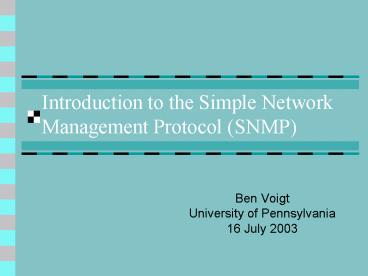Introduction to the Simple Network Management Protocol SNMP - PowerPoint PPT Presentation
1 / 13
Title:
Introduction to the Simple Network Management Protocol SNMP
Description:
University of Pennsylvania. 16 July 2003. Outline. What is the Simple ... delegation of naming in different branches allows concurrent development (.iso. ... – PowerPoint PPT presentation
Number of Views:58
Avg rating:3.0/5.0
Title: Introduction to the Simple Network Management Protocol SNMP
1
Introduction to the Simple Network Management
Protocol (SNMP)
- Ben Voigt
- University of Pennsylvania
- 16 July 2003
2
Outline
- What is the Simple Network Management Protocol?
- Does APNets need SNMP?
3
What is the Simple Network Management Protocol?
- What does it provide?
- How does it work?
- Why is it important?
4
Knowledge-Plane, 1988-style
- RFC 1067
- Simple interface read/write named parameters,
notification of parameters exceeding thresholds - Allows monitoring through reading statistical
counters maintained by nodes - Allow management by writing control registers
thus modifying network behavior - Traps make event-driven programming possible
5
Features of SNMP
- Simple atomic operations place few restrictions
on design of management system - Self-describing data format with descriptive
schema, like XML (but far more bandwidth-efficient
) - Latest version SNMPv3
- adds authentication and privacy to the protocol
- standardizes access control (see next slide)
6
SNMP Data Storage
- Parameters are stored in a hierarchical namespace
- allows multi-valued parameters
- delegation of naming in different branches allows
concurrent development (.iso.org.dod.internet.priv
ate.enterprises.) - management applications may be restricted to
particular subbranches - Standard view-based access control is
decentralized and kludgy, but SNMP allows new
methods of authentication, privacy, and
access-control to be added
7
SNMP In Todays Internet
- All enterprise-class, and increasing numbers of
workgroup networking devices support SNMP - Enterprise-class devices tend to use SNMP as the
primary management mechanism, and sell plugins
for SNMP Managers (HP OpenView, similar offerings
from IBM, ), facilitating centralized management
8
SNMP In Todays Internet
- Small devices tend to export only the required
statistical counters, and define a proprietary
management protocol - This prevents centralized control, unless all
devices are purchased from a single vendor (and
sometimes not even then)
9
Does APNets need SNMP?
- Why should we use it? (Or not?)
- What can we learn from it?
- What can we learn from its documentation?
10
Should we use SNMP?
- Interim Knowledge-Plane substitute
- Pros
- Huge amounts of information on network quality
already available - Management infrastructure exists to analyze
traffic patterns if we export MIBs from our
hardware/software devices - Cons
- PITA ASN.1 Notation, clock synchronization
11
Can we learn from SNMP?
- Strengths extensible, extensible, extensible
- Data transfer is (reasonably) efficient
- Principal authentication allows fine-grained
access control - Cons User Security Model is flexible and
powerful, but decentralized updates must be
propagated to all devices via SNMP
12
How about the documentation?
- SNMPv3 is Highly Extensible and Modularized
- Data Transfer, Authentication, Privacy,
Encryption, Access Control schemes may be
independently changed - Documentation shows a modern design and
presentation of a modular protocol - Documentation suggests modular implementation
which can be easily extended
13
Questions
- Further questions?































